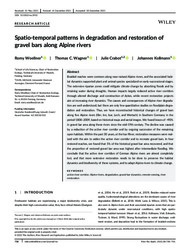Spatio‐temporal patterns in degradation and restoration of gravel bars along Alpine rivers
DOI: https://doi.org/10.1002/rra.3933
Persistent URL: http://resolver.sub.uni-goettingen.de/purl?gldocs-11858/10003
Persistent URL: http://resolver.sub.uni-goettingen.de/purl?gldocs-11858/10003
Woellner, Romy; Wagner, Thomas C.; Crabot, Julie; Kollmann, Johannes, 2022: Spatio‐temporal patterns in degradation and restoration of gravel bars along Alpine rivers. In: River Research and Applications, Band 38, 4: 738 - 756, DOI: 10.1002/rra.3933.
 |
Dokument öffnen: |
Braided reaches were common along near‐natural Alpine rivers, and the associated habitat dynamics supported plant and animal species specialized on early‐successional stages. The extensive riparian zones could mitigate climate change by absorbing floods and by retaining water during droughts. Human impacts largely reduced active river corridors through altered discharge and construction of dykes, while recent restoration projects aim at increasing river dynamics. The causes and consequences of Alpine river degradation are well understood, but there are only few quantitative studies on floodplain degradation and restoration. Thus, we have reconstructed historical changes of gravel bars along five Alpine rivers (Iller, Inn, Isar, Lech, and Wertach) in Southern Germany in the period 1808–2009, based on historical maps and aerial images. We found losses of >90% in gravel bar area along these rivers since the mid‐19th century. The decline was caused by a reduction of the active river corridor and by ongoing succession of the remaining open habitats. Within the past 30 years, at the Isar River, restoration measures were realized with the aim to widen the active river corridor and to recreate gravel bars. In four restored reaches, we found that 5% of the historical gravel bar area recovered, and that the proportion of restored gravel bar area was highest after intermediate flooding. We conclude that the active river corridors of German Alpine rivers are almost completely lost, and that more extensive restoration needs to be done to preserve the habitat dynamics and biodiversity of these systems, and to adapt Alpine rivers to climate change.
Statistik:
ZugriffsstatistikSammlung:
- Geographie, Hydrologie [454]
Schlagworte:
active river corridorAlpine rivers
degradation
gravel bar dynamics
remote sensing
river restoration
This is an open access article under the terms of the Creative Commons Attribution License, which permits use, distribution and reproduction in any medium, provided the original work is properly cited.

